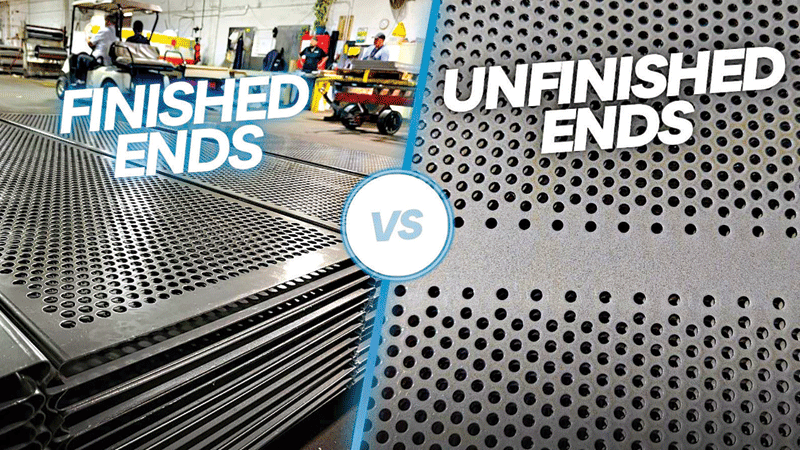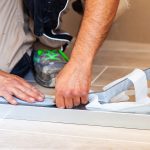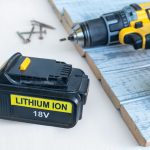
Perforating metal starts and ends with the most crucial part—the tooling that “punches” the metal (or other substrates) to achieve a specific pattern. As a tool is slammed repeatedly, it presses through at high speeds with immense power. With up to 800 strokes per minute, known as punches in the perforating industry, maintaining the tooling in proper working order is crucial for the machine’s efficiency and the frequency of the process. Given the force and frequency at which the tool operates, the strength of the specific tool must remain consistent from the start to the end of a run.
The whys and hows of finished and unfinished end patterns
The process must align perfectly when running a sheet or coil through a perforating press; otherwise, the material could become deformed. This is one reason why most perforated metal is run with an unfinished end pattern. As a sheet or coil is run through a press, it is crucial the metal and pattern line up perfectly with each stroke. If they are not aligned, the break in the pattern will immediately catch your eye, as it will be obvious that something is out of place. The tooling and press can work together by incorporating unfinished end patterns. By working together, everything will stay consistent, resulting in the tool lasting longer and minimizing any distortion to the metal that comes with the natural manufacturing process of perforating metal.
Unfinished end patterns simply get their name because the pattern remains “unfinished.” It is straightforward to tell the difference between a finished and an unfinished pattern. An unfinished end will have a consistent pattern throughout the sheet, and then it will stop or have a “break” before the pattern picks up again. This break in the pattern will look as though it does not belong and often has what appears to be a more significant gap from one set of punches (or strokes) to the next. Some customers get it and wonder what happened, but they quickly realize the material is fine just the way it is.

When would a finished end pattern be needed?
From a technical perspective, there is no reason to need a finished end pattern. The perforated metal is often run to standard sizes, such as 1,219-mm (48-in.) wide by 2,438-mm (96-in) long. These sheets or plates are then divided into smaller sections based on a customer’s needs. However, the finished end pattern is crucial for aesthetic reasons, especially if the entire sheet is used as it comes off the line. This is commonly seen in the architectural world, where designers seek a specific aesthetic for their facade.
Can every pattern be finished or unfinished?
The hope may be for a simple yes or a clear, hard-and-fast rule to determine when a pattern is finished or unfinished—but the reality is, it depends. Specific patterns and metal types work well as finished ends; some do not. So much of it depends on the open area and hole sizes, and it all helps determine what will work and what will not. When manufacturing and attempting to even out metal distortion caused by the sheer force of the punches from the press, the process is carefully kept within the appropriate tooling parameters.
Why are tools made with unfinished ends?
One of the reasons tools are made with unfinished ends is due to the hole pattern, especially when there is a high open area in the design. In this instance, it is impossible to design standard rows for the tooling because the holes are too close, and the punch heads will overlap. Another reason is the tool’s strength; if the rows of holes are too tight, there is a high risk the tooling will crack during the punching process. One last reason for unfinished tooling is to minimize stress on the material during the perforating process. More spread-out layouts generate less heat, allowing a perforator to make flatter parts at the press. The flatter the component is initially manufactured, the more straightforward it is when the sheet moves into the leveling process.

Options for a finished end that does not work in the desired pattern
As mentioned previously, most tooling is designed with an unfinished end. Yet, what if the only pattern the customer can use is unfinished? Sometimes, a process called “gagging the ends” is used. What does this mean? Simply put, it involves blocking a row of punches (the long, skinny bars resembling needles) from being used on the tool. Most tooling used in the perforation process has two rows of punches attached. To have a finished end pattern, one row needs to be held so it does not pierce the material. Blocking the row allows the perforator to create a finished end pattern for the customer’s specification.
Note that this option is only available on a perforating press equipped with a gagging system, which an estimator will inform about during the quoting process. Keep in mind that gagging a perforated press leads to increased costs and extended lead times due to the slowdown in the production process of the desired perforated pattern.

What are the various components making up a metal perforator toolset?
The standard tooling has five components: punch holder, stripper, die, die block, and
die shoe.
- Punch holder: Just as it sounds, the punch holder holds the punches in place. The punches, typically made of either cobalt or M2, are designed to stand up to the high-speed punches required by the perforating press.
- Stripper: The stripper acts as a guide for the punches and may hold the strip flat while the material is being perforated. In addition, the stripper pulls material from the ends of the punches during the withdrawal phase, so the material is continuously pulled and punched according to the pattern. The stripper also absorbs the shock of the punch at snap-through and withdrawal, ensuring the tooling used is not damaged and prevents material distortion.
- Die: A die is another crucial piece of the perforating process. This section holds the pattern that will be punched into the material as it is fed through the perforating process. Most dies either have two or four rows, depending on the pattern type and open area. As a quick rule of thumb, more expansive open areas are typically two-row dies, and narrower open areas are four-row dies. Given fewer punches happen simultaneously, two-row patterns take longer to finish perforating than four-row dies.
- Die block: Since the die itself is small and narrow, it is critical to the manufacturing process to stay on a secure platform, so it does not move when the force of the press strikes down. This is where the die block comes into play. The die is attached to the block to give it a stable base, delivering a perfect punch every time.
- Die shoe: The die shoe is integral to any perforating press. The shoe is a block of tool steel, which acts as a constant base for the die block to be attached to. The shoe remains flat and level for added stability as the force of each punch goes through the die and into the material.
Jim Erhart serves as the marketing manager for Accurate Perforating, Accurate Metal Fabrication, and SelectSpace Partitions. He has 20 years of experience working in the metal and steel industry with a focus on steel tubular (HSS) products in various sales and marketing roles. He received a Bachelor’s Degree in Human-Computer Interaction from DePaul University and an MBA with a concentration in Marketing from Saint Xavier University.





